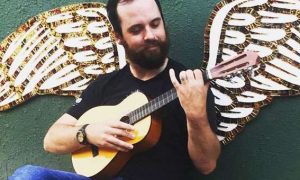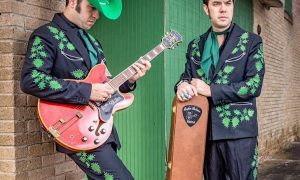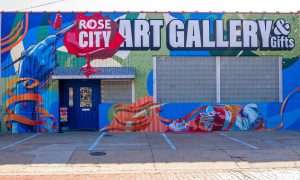Inside the Artist’s Studio:
James R. Pace
Defining an East Texas Spirit
By Derrick White
“An institution is the lengthened shadow of one man” – Ralph Waldo Emerson.
There are so many creative and talented artists in East Texas. I’m excited to see this genre of talent grow within our community; in terms of venues, pop-up shows, support and opportunities. There are many moving parts to our expanding East Texas visual arts scene including the Tyler Museum of Art, Downtown’s Gallery Main Street, Tyler Junior College, the University of Texas at Tyler, as well as local encouraging businesses like Strada Café, El Guapo Records, True Vine Brewing Company, and many more. However, there is one East Texan who is not just an artist but rather the bedrock institution of artistic voice coming from Tyler. I first encountered the work of James Robert Pace around 1991 while I was attending the University of North Texas. His painting, “Lunatic Celebration,” was exhibited in a group show in the fine arts gallery. It stopped me dead in my tracks. It was amazing. The work visually achieved everything I aspired to be as an artist. I wrote a report about the painting and I did multiple renditions of the composition in my sketchbook.
In later years, I curated an exhibition including the work of James Pace at the Art Corridor Gallery at Tarrant County Community College – Arlington. Today, I am privileged to call James Pace a colleague and a trusted friend. Pace’s work has evolved, experimented and changed over the years but it never fails to bring me to an ‘aha moment.’ His work immediately makes me realize, that the piece it is exactly how art should be; formed, composed, and constructed. James Pace’s influence on area artists would be hard to underestimate. Another artist friend and colleague, Paul Jones, worked with James Pace at UT Tyler while getting his undergraduate degree. The influence Pace carried through to Jones’ work was evident in his paintings long after the partnership ended.
Take Jones for example: when you see James’ work, it is precisely what you want your own art to look like. James Pace has shaped and invigorated many devotees.
James Pace is a Distinguished Professor of Visual Art at The University of Texas at Tyler where he has taught since 1985. He holds an MFA degree from Arizona State University and a BFA from the University of Oklahoma. Pace was appointed to the Oge’ Professorship in Visual Art, the White Fellowship for Excellence in Teaching, and received the Chancellor’s Council Teaching Award. He has exhibited his work nationally and internationally since 1976 and has received numerous awards for his paintings, drawings, prints, and mixed media work. He maintains an active studio practice in the forest of East Texas, where he lives with his artist wife, Philana Oliphant, poet daughter Aza Rene’ Pace, and an ever changing number of rescued dogs.
“Like most people who practice art making, I’ve done so for as long as I can remember. I’m sure most people find some kind of early support through family and friends, and thereby experience some type of self-actualization. I did, still do,” states the artist. Adding, “I grew up around university professors: historians, biologists, musicians, writers, and I was fortunate to have had intimate access to their lives. I witnessed their discipline, their fascination with their subject and it was inseparable from their daily lives. They chased curiosity. Seeing the lifestyle they practiced, I had an early sense I would combine my interest in art with a university life. It was all I ever considered doing.”
James Pace attended the University of Oklahoma School of Art, which during his matriculation he found to be a forward thinking, supremely funky, very diverse place. James remembers, “These people were freaks about making. It’s all we did, it’s all we talked about, and it’s all we spent what little money we had on.” Pursuing his MFA at Arizona State. Pace recalls loving the desert. “A friend and I spent many, many hours and days exploring the entire state. The environment had an indelible affect on both my work and my outlook. I came to believe in the importance of finding concepts through experience, getting lost, and with the help of others, finding my way back. The worst things can make the best things possible. This still happens to me today,” affirms the artist.
“Trained in printmaking, painting, and drawing, I always thought those were my media interests. But, one day, while working on a large canvas on the floor of my studio, I inadvertently dropped a piece of paper on the painting. The experience brought a flood of memory of long forgotten understanding. I knew mixed media was my way of finding a full voice of aesthetic consideration,” states Pace.
He concludes, “For the past 30 years it has been my greatest gift to work with Philana Oliphant. Her grace has been a wonder for me. You can see it in how she works, and in the results of those efforts. She is prolific, she is connected to the biggest ideas of connectedness, but mostly she has been a kind and loving partner. We have raised a daughter, who has taken the baton and continued to run faster than I could ever conceive. A recent MFA in poetry, now a Ph.D. candidate in creative writing, Aza to this very day has taught me more than I can express.”
“I believe, as artists, we are conduits to the zeitgeist. And frankly, this is our charge. If the culture permits us to do this, we should open up and let it out. Otherwise, we fail culture and ourselves,” declares James. Dedicated to the visual art spirit of East Texas and to seeing it prosper and grow as well as garner the statewide and national attention it deserves, he states, “Over the past several months, Philana and I have doubled the size of our shared studio. We are so very fortunate to have such a place to work. We realize we want to use this new studio for more than just ourselves. We hope this place may become a place for our community of artists and thinkers to congregate. We hope to facilitate a more cohesive, yet diverse arts community. This isn’t about our success, but helping in whatever ways we can, the next generation of artists.”


























